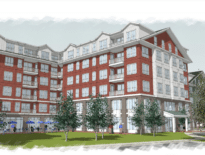
Preservation of Affordable Housing and Caste Capital proposed 119 units of affordable housing -- including 20 public housing units -- in a 12-story, $115 million, mass timber-framed building on the site of the West End Library. Image courtesy of MASS Design Group and The Architectural Team
Boston Mayor Michelle Wu pledged to grow the city’s supply of public housing units by roughly 30 percent in the next 10 years during her State of the City speech Tuesday night.
But making that dream into a reality will rely on fast action.
The Boston Housing Authority faces an end-of-September deadline to notify the federal Department of Housing and Urban Development where it thinks it will be able to add 2,891 new public housing units on city-owned land, BHA-owned land and in private developments over the next 10 years, BHA Administrator Kenzie Bok said Wednesday morning.
“One of the things we want people to take away from the mayor’s speech is that if you want to host these units [in your development], you should come talk to us in the spring and summer,” Bok said.
Thanks to well-intentioned efforts to de-densify and rebuild some the city’s extensive public housing developments 20 years ago, the Boston Housing Authority now has 2,891 fewer public housing units than it did when Congress fixed the number of units any local housing authority could operate in 1999 through a piece of legislation known as the Faircloth Amendment.
Between the headroom until the BHA hits its so-called “Faircloth cap” and an administrative change by the federal Department of Housing and Urban Development in July that nearly triples the federal funding available per unit of public housing per year, to that equivalent to a Section 8 rental voucher, the city housing authority now has the resources to finance the operation of new-build units, whether in fully public developments or mixed into private developments.
Read our full State of the City coverage:
– What Wu promised in her State of the City speech.
– Wu says no new incentives for housing developers.
“This used to be what of what we just did. Building more housing on the public side. But 40 years ago we opened the last new BHA development and we just stopped,” Bok said, noting that the BHA built around 4,000 units of public housing in the 1940s, 5,000 in the 1950s, 1,200 in the 1960s and 2,200 in the 1970s.
The fact that public housing units rent at rates far below typical affordable housing units, Bok said, means that the new homes can make a big difference in helping stabilize neighborhoods at risk of gentrifying, like Fields Corner in Dorchester, or bringing more socio-economic diversity to elite neighborhoods typically closed off to most Bostonians looking for a home.
“I hear a lot when I go around the city people saying ‘I don’t have enough public housing here in my neighborhood,'” Bok said, expressing hope that city residents would welcome the new developments.
Bok said the BHA plans to do a large amount of neighborhood outreach this spring and summer to identify locations that could host new public housing, whether owned by the BHA itself, one of the city of Boston’s roughly 1,200 underutilized parcels or in private housing developments being planned by for-profit and nonprofit developers. The BHA is already planning to partner with Preservation of Affordable Housing and Caste Capital to include 20 of its Faircloth units in the team’s planned 119-unit redevelopment of the Boston Public Library’s West End branch.
While the current interest rate environment has made it nearly impossible to finance private development, Bok said the BHA was planning to look expansively at its options to fund new developments, including tax credits and private financing. In addition, Bok hopes to convince mixed-income housing developers to add or convert BHA-subsidized units in developments that are already working their way through the approvals process.
“The thing about housing is that it doesn’t happen overnight anyways. I think that seeing the challenge of housing production in a high interest rate environment really underscores the need to seize the moment when interest rates become aligned. For us, we think that these are units we can produce all along through the decade, including projects that close in the coming year,” she said.






